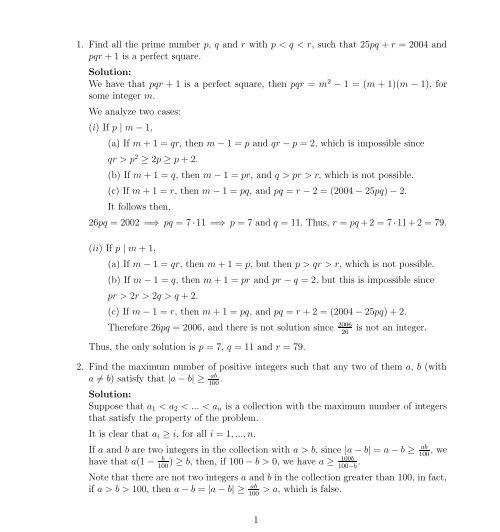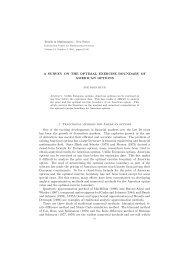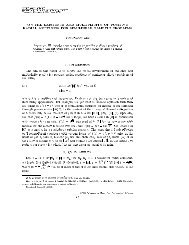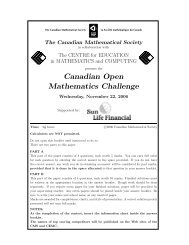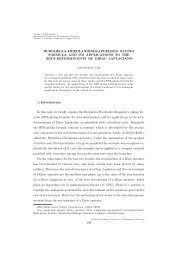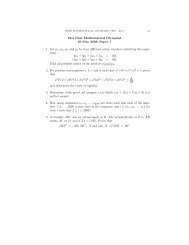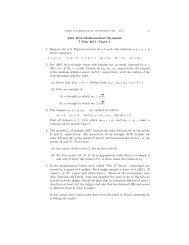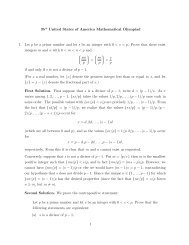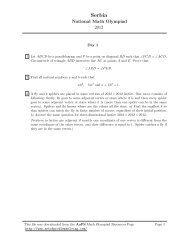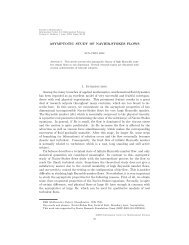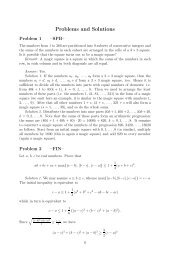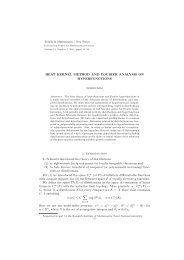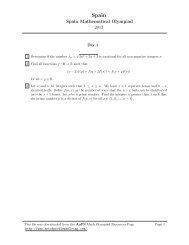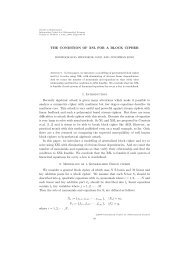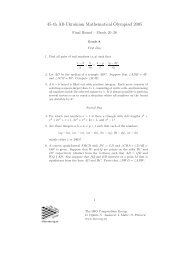XVIII Mexican Mathematical Olympiad
XVIII Mexican Mathematical Olympiad
XVIII Mexican Mathematical Olympiad
You also want an ePaper? Increase the reach of your titles
YUMPU automatically turns print PDFs into web optimized ePapers that Google loves.
1. Find all the prime number p, q and r with p < q < r, such that 25pq + r = 2004 and<br />
pqr + 1 is a perfect square.<br />
Solution:<br />
We have that pqr + 1 is a perfect square, then pqr = m 2 − 1 = (m + 1)(m − 1), for<br />
some integer m.<br />
We analyze two cases:<br />
(i) If p | m − 1,<br />
(a) If m + 1 = qr, then m − 1 = p and qr − p = 2, which is impossible since<br />
qr > p 2 ≥ 2p ≥ p + 2.<br />
(b) If m + 1 = q, then m − 1 = pr, and q > pr > r, which is not possible.<br />
(c) If m + 1 = r, then m − 1 = pq, and pq = r − 2 = (2004 − 25pq) − 2.<br />
It follows then,<br />
26pq = 2002 =⇒ pq = 7 · 11 =⇒ p = 7 and q = 11. Thus, r = pq + 2 = 7 · 11 + 2 = 79.<br />
(ii) If p | m + 1,<br />
(a) If m − 1 = qr, then m + 1 = p, but then p > qr > r, which is not possible.<br />
(b) If m − 1 = q, then m + 1 = pr and pr − q = 2, but this is impossible since<br />
pr > 2r > 2q > q + 2.<br />
(c) If m − 1 = r, then m + 1 = pq, and pq = r + 2 = (2004 − 25pq) + 2.<br />
Therefore 26pq = 2006, and there is not solution since 2006<br />
26<br />
is not an integer.<br />
Thus, the only solution is p = 7, q = 11 and r = 79.<br />
2. Find the maximum number of positive integers such that any two of them a, b (with<br />
a ≠ b) satisfy that |a − b| ≥ ab<br />
100 .<br />
Solution:<br />
Suppose that a 1 < a 2 < ... < a n is a collection with the maximum number of integers<br />
that satisfy the property of the problem.<br />
It is clear that a i ≥ i, for all i = 1, ..., n.<br />
If a and b are two integers in the collection with a > b, since |a − b| = a − b ≥ ab , we 100<br />
have that a(1 − b<br />
100b<br />
) ≥ b, then, if 100 − b > 0, we have a ≥ .<br />
100 100−b<br />
Note that there are not two integers a and b in the collection greater than 100, in fact,<br />
if a > b > 100, then a − b = |a − b| ≥ ab > a, which is false.<br />
100<br />
1
Also, we have that for integers a and b less than 100, it is true that<br />
100a<br />
100 − a ≥ 100b<br />
100 − b<br />
⇐⇒ 100a − ab ≥ 100b − ab ⇐⇒ a ≥ b.<br />
It is clear that {1, 2, 3, 4, 5, 6, 7, 8, 9, 10} is one collection with the property.<br />
Now, a 11 ≥ 100a 10<br />
100−a 10<br />
≥ 100·10<br />
100−10 = 100<br />
9<br />
> 11, which implies that a 11 ≥ 12.<br />
a 12 ≥ 100a 11<br />
100 − a 11<br />
≥<br />
a 13 ≥ 100a 12<br />
100 − a 12<br />
≥<br />
a 14 ≥ 100a 13<br />
100 − a 13<br />
≥<br />
a 15 ≥ 100a 14<br />
100 − a 14<br />
≥<br />
a 16 ≥ 100a 15<br />
100 − a 15<br />
≥<br />
a 17 ≥ 100a 16<br />
100 − a 16<br />
≥<br />
a 18 ≥ 100a 17<br />
100 − a 17<br />
≥<br />
100 · 12<br />
100 − 12 = 1200<br />
88 > 13 =⇒ a 12 ≥ 14.<br />
100 · 14<br />
100 − 14 = 1400<br />
86 > 16 =⇒ a 13 ≥ 17.<br />
100 · 17<br />
100 − 17 = 1700<br />
83 > 20 =⇒ a 14 ≥ 21.<br />
100 · 21<br />
100 − 21 = 2100<br />
79 > 26 =⇒ a 15 ≥ 27.<br />
100 · 27<br />
100 − 27 = 2700<br />
73 > 36 =⇒ a 16 ≥ 37.<br />
100 · 37<br />
100 − 37 = 3700<br />
63 > 58 =⇒ a 17 ≥ 59.<br />
100 · 59<br />
100 − 59 = 5900<br />
41 > 143 =⇒ a 18 ≥ 144.<br />
And since there are not more than two integers greater than 100, the maximum collection<br />
has 18 numbers.<br />
One collection with 18 integers that satisfy the condition is,<br />
{1, 2, 3, 4, 5, 6, 7, 8, 9, 10, 12, 14, 17, 21, 27, 37, 59, 144}.<br />
3. Let Z and Y be the tangency points of the incircle of the triangle ABC with the sides<br />
AB and CA, respectively. The parallel line to Y Z through the midpoint M of BC,<br />
meets CA in N. Let L be the point in CA such that NL = AB (and L on the same<br />
side of N than A). The line ML meets AB in K. Prove that KA = NC.<br />
Solution:<br />
Let N ′ be the intersection point between MN and AB. Since AZ and AY are tangent<br />
to the incircle of ABC, then AZ = AY , and since N ′ N is parallel to ZY , we have that<br />
AN ′ = AN.<br />
By Menelaus’s theorem in the triangle ABC, with N ′ , M and N collinear, we get<br />
AN ′<br />
· BM · CN = −1, and BM = MC ⇒ CN = BN ′ .<br />
N ′ B MC NA<br />
Observe that AC = AN + NC = AN ′ + NC = (AB + BN ′ ) + NC = AB + 2NC and<br />
that AC = AL + LN + NC = AL + AB + NC, therefore AL = NC.<br />
2
K<br />
Z<br />
A<br />
L<br />
Y<br />
B<br />
N ′<br />
M<br />
N<br />
C<br />
Applying again Menelaus’s theorem to the triangle ABC, with K, M and L collinear,<br />
we get AK · BM · CL<br />
CL<br />
= −1 ⇒ = KB ⇒ CL − 1 = KB − 1 ⇒ CL−LA = KB−KA ⇒<br />
KB MC LA LA KA LA KA LA KA<br />
CL−CN<br />
= AB ⇒ NL = AB , and NL = AB ⇒ LA = KA ⇒ KA = CN.<br />
LA KA LA KA<br />
4. At the end of a soccer tournament in which any pair of teams played between them<br />
exactly once, and in which there were not draws, it was observed that for any three<br />
teams A, B and C, if A defeated B and B defeated C, then A defeated C.<br />
Any team calculated the difference (positive) between the number of games that it won<br />
and the number of games it lost. The sum of all these differences was 5000. How many<br />
teams played in the tournament? Find all possible answers.<br />
Solution:<br />
Let n be the number of teams in the tournament, since any team played against all<br />
the other teams exactly once, then every team played n − 1 games.<br />
Suppose that two teams X and Y , both won k games, then if X defeated Y , X defeated<br />
all the teams that Y defeated (by hypothesis), and then X won at least k + 1 games,<br />
which contradicts that X and Y won k games; the same argument is used to show that<br />
Y did not defeat X. Therefore, since there are not draws, there are not two teams with<br />
the same number of wins. Since there are at most n possible values for the number of<br />
games won, we have that the teams won n − 1, n − 2, ..., 1, 0 in some order.<br />
If one team won h games, then it lost n−1−h games, for which its difference (positive)<br />
between the number of games won and the number of games lost is |n − 1 − 2h|.<br />
Let D be the sum of all these differences, then:<br />
a) If n is even, n = 2m with m an integer and<br />
D = (2m − 1) + (2m − 3) + ... + 1 + 1 + ... + (2m − 3) + (2m − 1) = 2[(2m − 1) + (2m −<br />
3) + ... + 1] = 2m 2 .<br />
b) If n is odd, n = 2m + 1 with m an integer and<br />
D = 2m + (2m − 2) + ... + 2 + 0 + 2 + ... + (2m − 2) + 2m = 2[2m + (2m − 2) + ... + 2] =<br />
4[m + (m − 1) + ... + 1] = 4 m(m+1)<br />
2<br />
= 2m(m + 1).<br />
3
¢<br />
¡<br />
Since D = 5000, then:<br />
a) 2m 2 = D = 5000 ⇒ m = 50 ⇒ n = 2m = 100.<br />
b) 2m(m + 1) = D = 5000 ⇒ m(m + 1) = 2500, but 49 · 50 < 2500 < 50 · 51, therefore<br />
there is not solution in this case.<br />
Thus the only possible answer is n = 100.<br />
5. Let A and B be two circles such that the center O of B lies in A. Let C and D be the<br />
two intersection points of the circles. Let A be a point on A and let B be a point on<br />
B such that AC is tangent to B in C and BC is tangent to A in C. The line segment<br />
AB meets B again in E and also meets A again in F . The line CE meets A again in<br />
G and the line CF meets the line GD in H. Prove that the intersection point of GO<br />
and EH is the center of the circumcircle of the triangle DEF .<br />
Solution:<br />
C<br />
A<br />
E<br />
O<br />
F<br />
H<br />
B<br />
G<br />
D<br />
Since O is the center of B, we have CO = OD and ∠DCO = ∠CDO, and since CGDO<br />
is cyclic, ∠CGO = ∠CDO = ∠DCO = ∠DGO, therefore GO is an internal angle bisector<br />
of ∠CGD.<br />
Since CA is tangent to B, we have ∠ACO = 90 ◦ , then, ∠AF O = 90 ◦ (this follows<br />
since AO is the diameter of A or since ACOF is cyclic). Then OF is the perpendicular<br />
bisector of EB, which implies EF = F B.<br />
Now, since CA is tangent to B and CB is tangent to A, we have ∠ACE = ∠CBE = α<br />
and ∠BCF = ∠CAF = β, then ∠CEF = ∠ACE + ∠EAC = α + β = ∠CBF +<br />
∠BCF = ∠CF E, hence EC = CF .<br />
Also, CADF is cyclic, then ∠DAF = ∠DCF = γ, ∠CDF = ∠CAF = β and<br />
∠COD = 180 ◦ −∠DAC, and since CBDE is also cyclic, we obtain ∠DBE = ∠DCE =<br />
θ.<br />
Since the triangles CAE and BCF are similar by having corresponding equal angles,<br />
then AE = CE ⇒ AE = CF . Taking the power of E with respect to A, we get<br />
CF BF CE BF<br />
AE · EF = CE · EG ⇒ AE = EG<br />
CF<br />
, and then = EG ⇒ EG = EF = 1 ⇒ EG = CF .<br />
CE EF BF EF CF BF<br />
4
In the triangle ABC we have 180 ◦ = ∠CAB+∠ABC +∠BCA = β+α+(β+γ+θ+α),<br />
then ∠COD = 180 ◦ −∠DAC = 180 ◦ −(∠CAF +∠F AD) = 180 ◦ −(β+γ) = 2α+β+θ;<br />
and on the other hand ∠COD = 2∠CBD = 2(∠CBE + ∠EBD) = 2(α + θ), then<br />
2α + β + θ = 2α + 2θ ⇒ β = θ. ⇒ ∠CDF = ∠DCE ⇒ F D ‖ CG.<br />
Now, since F D and CG are parallel, DF CG is an isosceles trapezoid (since it is also<br />
cyclic), and then we have GD = CF and HD = HF ⇒ HD = HF ⇒ HG = HC,<br />
DG F C<br />
therefore the triangles CHG and F HD are isosceles. Moreover, since GE = EC, then<br />
HE is the perpendicular bisector of GC, and since F DGC is an isosceles trapezoid,<br />
HE is also a perpendicular bisector of F D.<br />
Finally, since GD = CF = EG, the triangle EGD is isosceles, and since GO is an<br />
internal angle bisector of ∠EGD, then GO is also a perpendicular bisector of ED,<br />
therefore, the intersection of GO and EH is the circumcenter of the triangle DEF .<br />
6. What is the maximum number of possible change of directions in a path traveling on<br />
the edges of a rectangular array of 2004 × 2004, if the path does not cross the same<br />
place twice?.<br />
Solution:<br />
Let R be a path with the maximum number of possible change of directions. We<br />
can assume without loss of generality that it started in a vertical edge. We color<br />
the horizontal edges of the rectangular array, black and white in alternating fashion,<br />
starting with black. Then each vertex of the array is either white or black.<br />
For the path R, we can make a list L(R) of the colors of the vertices that the path<br />
visit, for instance: BBNNBNNNB (where B is white, and N is black).<br />
Observe that R has a change of direction in a vertex if and only if the adjacent vertices<br />
to it in R have different color.<br />
We separate L(R) in two lists: L 1 (R) formed by the odd positions of L(R), and L 2 (R)<br />
formed by the even positions of L(R). Then, the number of change of directions of R<br />
is the sum of the change of color of L 1 (R) and L 2 (R); moreover, by the way we color<br />
the array, some of the lists start with B, suppose that this is L 1 (R).<br />
Let i be the number of change of color in L 1 (R) and let j be the number of change<br />
of directions in L 2 (R), then the number of B in L 1 (R) is at least i+1 and in L<br />
2 2 is at<br />
least j i+j+1<br />
, therefore, the number of B’s in L(R) is at least , then since 2004·2005 is<br />
2 2 2<br />
the number of B in all the array, i+j+1 2004·2005 ⇒ i + j 2004 · 2005 − 1.<br />
2 2<br />
5


